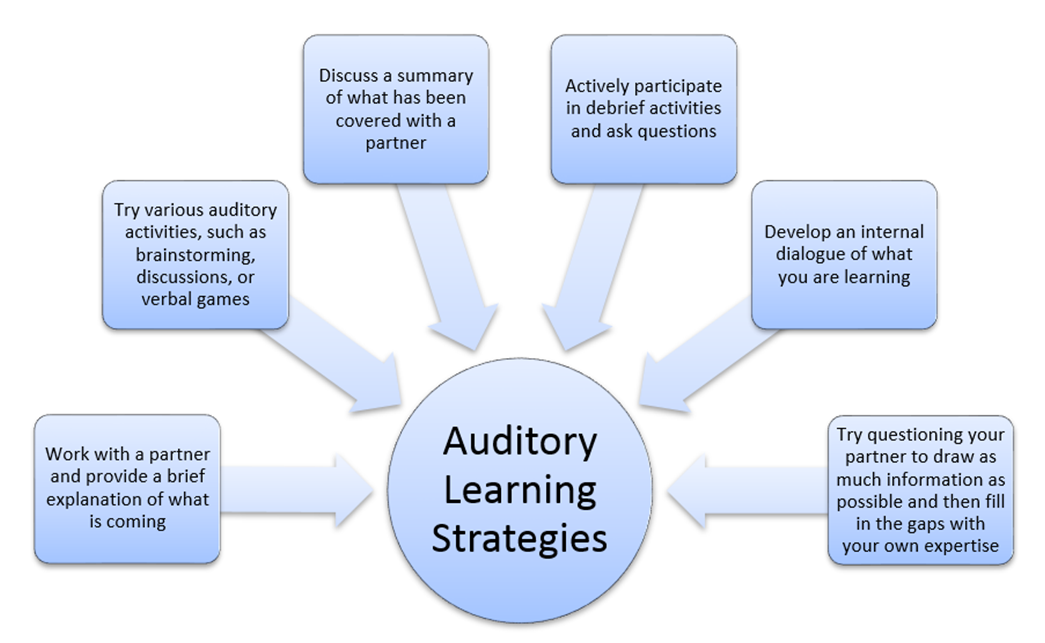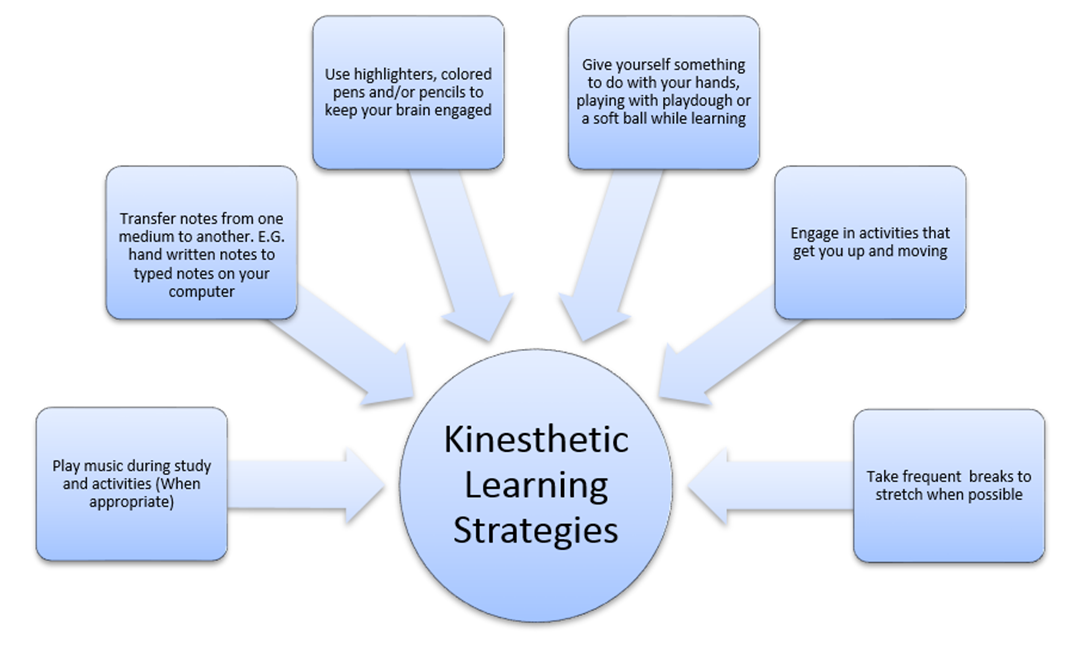2.3 Discover Your Learning Style and Strengths
– Albert Einstein
Questions to consider:
- What are learning styles, and do they really work?
- How do I take advantage of learning styles in a way that works for me?
- How can I combine learning styles for better outcomes?
Learning Objectives
- Define learning styles, and recognize your preferred learning style(s)
- Apply your preferred learning styles to classroom scenarios
- Discover your character strengths as a learner
The Three Learning Styles
We can all remember listening to a teacher talk, and copying notes off the chalkboard. However, when it comes to learning, one size doesn’t fit all. People have different learning styles and preferences, and these can vary from subject to subject.
Learning styles are also called learning modalities. Walter Burke Barbe and his colleagues proposed the following three learning modalities (often identified by the acronym VAK):
- Visual learning refers to a mode of learning where students rely on graphic aids to remember and learn material. Examples include pictures, shapes, sculptures, paintings, maps and graphs. Visual learners learn best by color-coding their notes, making to-do lists and using concept maps to organize their thoughts.
- Auditory learning is a style of learning in which an individual learns most efficiently through hearing and listening. Examples include speaking, listening, rhymes, tone and chants. Auditory learners learn best by listening to a lecture or a podcast.
- Kinesthetic learners are hands on learners who prefer using their body, hands, and sense of touch. An example would be doing something physical, such as examining an object rather than reading about it or looking at an illustration. Gestures, body movement, manipulating objects and positioning are also examples of kinesthetic learning style.
The Truth about Learning Styles
- A person does not always prefer the same learning style all the time or for each situation. For example, some learners might enjoy lectures during the day but prefer reading in the evenings. Or they may prefer looking at diagrams when learning about mechanics but prefer reading for history topics.
- There are more preferences involved in learning than just the three that became popular. These other preferences can become nearly impossible to make use of within certain styles. For example, some prefer to learn in a more social environment that includes interaction with other learners. Reading can be difficult or restrictive as a group effort. Recognized learning styles beyond the original three include: social (preferring to learn as a part of group activity), solitary (preferring to learn alone or using self-study), or logical (preferring to use logic, reasoning, etc.).
- Students that thought they were limited to a single preferred learning style found themselves convinced that they could not do as well with content that was presented in a way that differed from their style. For example, a student that had identified as a visual learner might feel they were at a significant disadvantage when listening to a lecture. Sometimes they even believed they had an even greater impairment that prevented them from learning that way at all.
- Some forms of learning are extremely difficult in activities delivered in one style or another. Subjects like computer programming would be almost impossible to learn using an aural learning style. And, while it is possible to read about a subject such as how to swing a bat or how to do a medical procedure, actually applying that knowledge in a learning environment is difficult if the subject is something that requires a physical skill.
Knowing and Taking Advantage of Learning Styles in a Way That Works for You
ACTIVITY: IDENTIFYING PREFERRED LEARNING STYLES
Objective
- Define learning styles, and recognize your preferred learning style(s)
Directions
- Now it’s time to consider your preferred learning style(s). Take the VARK Questionnaire here.
- Review the types of learning preferences.
- Identify three different classes and describe what types of activities you typically do in these classes. Which learning style(s) do these activities relate to?
- Describe what you think your preferred learning style(s) is/are. How do you know?
- Explain how you could apply your preferred learning style(s) to studying.
- What might your preferred learning style(s) tell you about your interests? Consider which subjects and eventual careers you might like.
Defining Multimodal Learning
While completing the learning-styles activity, you might have discovered that you prefer more than one learning style. Applying more than one learning style is known as multimodal learning. This strategy is useful not only for students who prefer to combine learning styles but also for those who may not know which learning style works best for them. It’s also a good way to mix things up and keep learning fun.
For example, consider how you might combine visual, auditory, and kinesthetic learning styles to a biology class. For visual learning, you could create flash cards containing images of individual animals and the species name. For auditory learning, you could have a friend quiz you on the flash cards. For kinesthetic learning, you could move the flash cards around on a board to show a food web (food chain).
Strategies to Develop all Learning Styles



Celebrate your Strengths and Develop New Ones!
Discovering your strengths helps you understand what really makes you stand out and how to use the natural abilities for reaching your full potential by growing your strengths further. There are several assessments available ; some have a small cost and some are free. Try out the following to discover your strengths and strategies to strengthen as well as develop new strengths.
- Take the test and download the results here: HIGH5 Personality Test Review the HIGH5 Strengths List, celebrate your top 5 strengths and create a plan to develop other strengths. HIGH5-Strengths-Sequence-Sample
- Purchase the Clifton StrenthsQuest student code to find out your top strengths and ways to develop them further.
- Take the free VIA Character Strengths Survey
Now that you are aware of your learning style and your strengths, it is time to discover further about the kind of student you are and the kind you want to become. In order to successfully improve as a student it is critical to understand how you learn best. The following two activities will take you through the process of exploring just that!
The Experiential learning model also called Kolb’s learning cycle was developed by David A. Kolb. The model provides an insight into how individuals learn. The model was published in a book entitled “Experiential Learning” in 1984. The Discovery Wheel is a tool created based on the Kolb’s Learning Cycle. It will provide you with an opportunity to tell the truth to yourself about the kind of student you are and the kind of student you want to become. This is not a test. There are no trick questions, and the answers will have meaning only for you. The Discovery Wheel is a picture of how you see yourself as a student. The closer the shading comes to the edge of the circle, the higher the evaluation in that area. You can access this activity here: Discovery Wheel Activity
Source : https://www.youtube.com/watch?v=rvqoFhk6N2A&t=3s
Transcript
To Access the Video Transcript:
1. Click on “YouTube” on the bottom-right of the video. This will take you directly to the YouTube video.
2. Click on the More Actions icon (represented by three horizontal dots)
3. Click on “Open Transcript”

Activity Learning Style Inventory
Engage in this online resource to discover your learning style.
Key Takeaways
- Learning styles are also called learning modalities. There are three learning styles Visual, Kinesthetic and Auditory.
- A person does not always prefer the same learning style all the time or for each situation.
- Applying more than one learning style is known as multimodal learning.
- To become a successful learner, it is important to become a multimodal learner.
- Assessing your preferred approach to learning and then practicing strategies to develop visual, auditory, and kinesthetic/tactile learning skills will set you up for success in college.
- It is important to focus on and develop our strengths to become successful both academically as well as professionally.
- Discovering what type of learner you are will assist you in creating a plan for success and growth.
Image Long Descriptions
Image 1: Following are the tips shared in the chart titled “Auditory Learning Strategies” starting from left to right:
- Work with a partner and provide a brief explanation of what is coming
- Try various auditory activities, such as brainstorming, discussions, or verbal games
- Discuss a summary of what has been covered with a partner
- Actively participate in debrief activities and ask questions
- Develop an internal dialogue of what you are learning
- Try questioning your partner to draw as much information as possible and then fill in the gaps with your own experience
Image 2: Following are the tips shared in the chart titled “Visual Learning Strategies” starting from left to right:
- Create your own outlines, agendas, handouts, etc. for reading, taking notes
- Use or create graphs, charts, illustrations
- Use coloured markers and highlighters in your notes
- envision the topic or act out the subject matter
- Show diagrams to a study partner and then explain them
- Supplement textual information with illustrations, images, diagrams
- Eliminate potential distractions
- Collect handouts to read after the learning session and add your own notes to it
Image 3: Following are the tips shared in the chart titled “Kinesthetic Learning Strategies” starting from left to right:
- Play music during study and activities (when appropriate)
- Transfer notes from one medium to another. Example. Hand written notes to typed notes on your computer
- Use highlighters, coloured pens and/or pencils to keep your brain engaged
- Give yourself something to do with your hands, playing with playdough or a soft ball while learning
- Engage in activities that get you up and moving
- Take frequent breaks to stretch when possible
Attributions and References
This chapter contains adaptations from:
Bruce, L. (2016). College Success. Provided by: Lumen Learning.
Book URL: https://www.coursehero.com/study-guides/collegesuccess-lumen/
Section URL: https://courses.lumenlearning.com/collegesuccess-lumen/chapter/the-learning-process/#footnote-294-1
License: CC BY: Attribution
Baldwin, A. (2020). College Success. Provided by: Open Stax.
Book URL: Access for free at https://openstax.org/books/college-success/pages/1-introduction
Section URL: https://openstax.org/books/college-success/pages/2-4-learning-styles
License: CC BY: Attribution
CC LICENSED CONTENT, SHARED PREVIOUSLY
Learning Styles. Provided by: Wikipedia. Located at: https://en.wikipedia.org/wiki/Learning_styles. License: CC BY-SA: Attribution-ShareAlike

